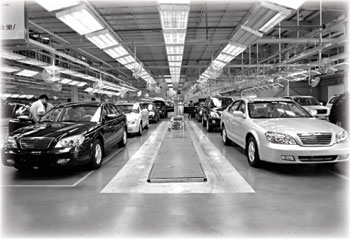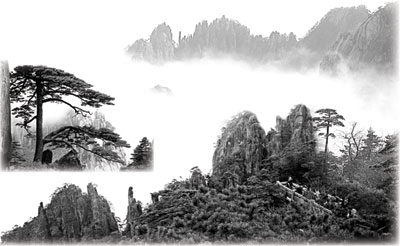The many wonders of Anhui
Anhui, located at the lower reaches of the Yangtze River, has an area of 139,600 square kilometers and a population of 66 million.
A car production line of the Chery Automobile Co Ltd in Wuhu, Anhui Province. Chery is a famous home-grown automobile brand in China. |
Connecting the nation's central and eastern regions, Anhui enjoys a unique position on China's economic map.
It borders Jiangsu and Zhejiang provinces to the east, Shandong to the north, Hubei and Henan to the west and Jiangxi to the south. These neighboring areas have a population of nearly 500 million and account for 40 percent of the nation's gross domestic product.
Home to such attractions as Huangshan Mountain - a world natural and cultural heritage site designated by the United Nations Educational, Scientific and Cultural Organization (UNESCO) - and the Jiuhua Mountain, a holy spot for Buddhists, Anhui is an important destination for tourists wishing to enjoy its natural and cultural wonders.
Anhui's rich natural resources include 4.12 million hectares of farmland, suitable for growing many kinds of crops, while its water resource volume totals 71.6 billion cubic meters. It has also constructed a well-developed irrigation and water conservation network.
The province's 3.6 million hectares of forests are home to about 2,500 plant and 500 animal species.
A total of 138 minerals have been found in Anhui, with its proven reserves of coal, iron, copper and limestone ranking among the top 10 in the country.
Huangshan Mountain and its neighboring areas are must-see destinations for Chinese and foreign tourists alike. The region has won the UNESCO titles of world natural heritage site, world cultural heritage site and world geopark.
Anhui has a competitive strength in scientific and technological research, with 1.19 million people engaged in research and engineering. It also has well-developed infrastructural facilities.
The total length of highways in Anhui reached 146,700 km in 2006, including 1,747 km of expressways. The total mileage covered by expressways is expected to hit 3,500 km in 2010.
Featuring attractive scenery, unique geological structure and rich cultural legacies, the Huangshan Mountain is a world natural and cultural heritage site and a world geopark designated by the United Nations Educational, Scientific and Cultural Organization. |
Key national railway lines as the Beijing-Kowloon, Beijing-Shanghai and Liangyungang-Lanzhou railways link the province with the rest of the country, making Anhui a leading province in East China in terms of railway density and length.
Anhui has also played an important role in the field of civil navigation, with two international airports in Hefei and Huangshan, and six domestic airports.
The Yangtze, Huaihe and Xin'an rivers constitute the major navigable waterways in Anhui. Five large ports, including Anqing, Tongling, Wuhu, Maanshan and Chizhou, have been built along the Yangtze River, linking the province with the rest of the world.
In terms of telecommunications, the province has developed comprehensive digital and mobile transmission networks.
In addition, the province's installed power generation capacity reached 16.02 million kilowatts in 2006, generating 73.4 billion kilowatt-hours of electricity.
(China Daily 05/10/2007 page20)
















